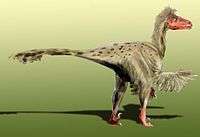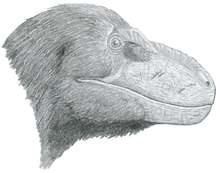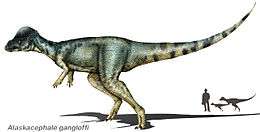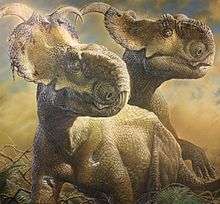Prince Creek Formation
| Prince Creek Formation Stratigraphic range: Late Cretaceous-Paleocene, 80–60 Ma | |
|---|---|
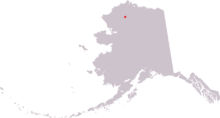 General location of the Prince Creek Formation, in red | |
| Type | Geological formation |
| Sub-units | Kikak-Tegoseak Quarry, Kogosukruk Tongue, Ocean Point, Coleville River Bluff |
| Underlies | Sagavanirktok Formation |
| Overlies | Schrader Bluff Formation |
| Lithology | |
| Primary | sandstone, mudstone[1] |
| Other | siltstone, carbonaceous shale, ash-fall[1] |
| Location | |
| Region |
|
| Country |
|
The Prince Creek Formation is a geological formation in Alaska with strata from the early Campanian stage of the Upper Cretaceous to the Danian of the Paleocene, between 80 and 60 million years ago. Dinosaur remains are among the fossils that have been recovered from the formation.[2]
Age
The Prince Creek Formation aged from 80 to 60 million years ago. The Kikak-Tegoseak Quarry, where almost all of the dinosaur fossil are from, is located near the middle of the formation, and is about 70.6 to 69.1 million years ago.[3][4] A lower section, the Kogosukruk Tongue, ages from 72 to 71 million years ago, in the latest Campanian.[5] The youngest part of the formation is Ocean Point, which extends into the Paleogene, at the end of the Danian, based on the age of ostracods and mollusks.[6] In the middle of the formation is the Coleville River Bluff, which extends from the Late Campanian to the Middle/Late Maastrichtian, in which pollen spores are common.[7]
Habitat
During the time when the Prince Creek Formation was deposited, the earth was going through a greenhouse phase. The rocks in it are alluvial, and were, at the time of burial, on a muddy coastal plain. Leafy plants, roots and pollen are known from the formation, and they show that trampling by dinosaurs was common. It can be proven that during the Maastrichtian the Prince Creek Formation bordered a large body of water by the presence of gypsum and pyrite in nearby rock. Large amounts of plants material are represented by peridonoid dinocysts, algae, fungal hyphae, fern and moss spores, projectates, Wodehouseia edmontonicola, hinterland bisaccate pollen, and pollen from trees, shrubs, and herbs. Concluded on the large amounts of dinosaurs and flora, the Prince Creek Formation was likely a polar woodland lacking ground ice with dinosaurs dominating and angiosperms towering above them. The mean temperature was 5-6 °C, with the mean temperature during the cold months being 2-4 °C and the mean temperature during the warm months being 10-12 °C. Mean annual precipitation was 500-1500mm/year.[1]
Vertebrate paleofauna
Dinosaurs
Theropods
Indeterminate tyrannosaurid remains present, mostly in the form of teeth. The teeth are from the Kikak-Tegoseak Quarry, Liscomb Quarry, and Byers Bed, totaling 8 teeth.[8]
Color key
|
Notes Uncertain or tentative taxa are in small text; |
| Theropods of the Prince Creek Formation | ||||||
|---|---|---|---|---|---|---|
| Genus | Species | Location | Stratigraphic position | Abundance | Notes | Images |
|
Liscomb Quarry[8] Kikak-Tegoseak Quarry[8] Byers Bed[8] |
Middle Maastrichtian[3] |
Fossilized teeth[8] |
| |||
|
N. hoglundi[3] |
Kikak-Tegoseak Quarry[3] |
Middle Maastrichtian[3] |
One partial skull including a bone near the front of the maxilla and the front of the lower jaw.[3] |
Nanuqsaurus is a dwarf tyrannosaurid closely related to Lythronax, Tyrannosaurus, and Tarbosaurus.[3] |
| |
|
Old Bone Beach[8] |
Teeth[8] |
| ||||
|
T. sp[3] |
Kikak-Tegoseak Quarry[3] Liscomb Quarry[8] Byers Bed[8] Magical Mystery Bar[10] |
Middle Masstrichtian[3] |
Remains of T. sp. are approximately 50% larger than specimens from Alberta and Montana.[3] Remains were previously assigned to T. formosus.[9] The most abundant theropod.[10] |
| ||
Ornithischians
Color key
|
Notes Uncertain or tentative taxa are in small text; |
| Ornithischians of the Prince Creek Formation | ||||||
|---|---|---|---|---|---|---|
| Genus | Species | Location | Stratigraphic position | Abundance | Notes | Images |
|
A. gangloffi[11] |
Kogosukruk Tongue[12] |
Late Campanian[5] |
A squamosal, and the back of the dome.[5] |
The first pachycephalosaurine from Alaska discovered.[5] |
| |
|
Kikak-Tegoseak Quarry[4] |
Early Maastrichtian, approximately 69 mya[4] |
An abundance of skeletal remains,[4] including an immature juvenile.[13] |
The youngest of the Pachyrhinosaurus species, found in one of the highest latitudes of centrosaurine discoveries.[4] A discovery in the Kikak-Tegoseak Quarry was identified in 2013 as a juvenile of Pachyrhinosaurus perotorum. This discovery shows that the crest started to develop in the front of the snout, then extending farther back until it reaches the eye.[13] |
| ||
|
Indeterminate[14] |
Teeth[14] |
Remains previously attributed to Thescelosaurus.[14] |
| |||
|
U. kuukpikensis |
Kikak-Tegoseak Quarry[4] |
Early Maastrichtian |
Juvenile specimens |
An edmontosaurin saurolophine hadrosaur related to Edmontosaurus. |
| |
|
Indeterminate[14] |
Indeterminate[14] |
One tooth[14] |
A single "hypsilophodontid" cheek tooth not attributable to Parksosaurus or Thescelosaurus.[14] |
|||
Birds
Color key
|
Notes Uncertain or tentative taxa are in small text; |
| Birds of the Prince Creek Formation | ||||||
|---|---|---|---|---|---|---|
| Genus | Species | Location | Stratigraphic position | Abundance | Notes | Images |
|
Gruipeda |
G. vegrandiunis |
Footprints from a small bird. |
||||
Plants
Color key
|
Notes Uncertain or tentative taxa are in small text; |
| Plants of the Prince Creek Formation[7] | ||||||
|---|---|---|---|---|---|---|
| Genus | Species | Location | Stratigraphic position | Abundance | Notes | Images |
|
Paxataxodium[12] |
P. wigginsii[12] |
Kogosukruk Tongue[12] |
Late Campanian[5] |
A conifer, one of two from the region.[12] |
||
|
Hollickia[12] |
H. quercifolia[12] |
Kogosukruk Tongue[12] |
Late Campanian[5] |
Leaves[12] |
An angiosperm, known from leaves.[12] |
|
|
Quereuxia[12] |
Q. angulata[12] |
Kogosukruk Tongue[12] |
Late Campanian[5] |
An aquatic angiosperm.[12] |
||
|
Equisetites[12] |
E. sp.[12] |
Kogosukruk Tongue[12] |
Late Campanian[5] |
|||
|
Pulcheripollenites |
P. krempii |
Coleville River Bluff |
Late Campanian to Early Maastrichtian |
Pollen spores |
Also found in the Schrader Bluff Formation. |
|
|
cf. Proteacidites |
cf. P. sp. |
Coleville River Bluff |
Late Campanian to Early Maastrichtian |
Pollen spores |
Also found in the Schrader Bluff Formation. |
|
|
cf. Polycingulatisporites |
cf. P. reduncus |
Coleville River Bluff |
Late Campanian to Early Maastrichtian |
Pollen spores |
Also found in the Schrader Bluff Formation. |
|
|
Podocarpidites |
P. sp. |
Coleville River Bluff |
Late Campanian to Early Maastrichtian |
Pollen spores |
Also found in the Schrader Bluff Formation. |
|
|
Ovoidites |
O.? sp. |
Coleville River Bluff |
Late Campanian to Early Maastrichtian |
Pollen spores |
Also found in the Schrader Bluff Formation. |
|
|
O. sp. |
Coleville River Bluff |
Late Campanian to Early Maastrichtian |
Pollen spores |
Also found in the Schrader Bluff Formation. |
||
|
O. parvus |
Coleville River Bluff |
Late Campanian to Early Maastrichtian |
Pollen spores |
Also found in the Schrader Bluff Formation. |
||
|
O. arcticus |
Coleville River Bluff |
Late Campanian to Early Maastrichtian |
Pollen spores |
Also found in the Schrader Bluff Formation. |
||
|
Osmundacidites |
O. wellmanii |
Coleville River Bluff |
Late Campanian to Early Maastrichtian |
Pollen remains |
Common in the Early Maastrichtian. Also found in the Schrader Bluff Formation. |
|
|
Mantonisporites |
M. sp. indet |
Coleville River Bluff |
Late Campanian to Early Maastrichtian |
Pollen remains |
Also found in the Schrader Bluff Formation. |
|
|
Mancicorpus |
M. pseudosenonicus |
Coleville River Bluff |
Late Campanian to Early Maastrichtian |
Pollen remains |
Also found in the Schrader Bluff Formation. |
|
|
Lycopodiacidites |
L. sp. |
Coleville River Bluff |
Late Campanian to Early Maastrichtian |
Pollen remains |
Also found in the Schrader Bluff Formation. |
|
|
Lunatadinium |
L. dissolutum |
Coleville River Bluff |
Late Campanian to Early Maastrichtian |
Pollen remains |
Also found in the Schrader Bluff Formation. |
|
|
Indeterminate |
Indeterminate |
Coleville River Bluff |
Late Campanian to Early Maastrichtian |
Septate fungal hypha. |
Also found in the Schrader Bluff Formation. |
|
|
Leosphaeridia |
L. "stellata" |
Coleville River Bluff |
Late Campanian to Early Maastrichtian |
Pollen remains |
Common in the Early Maastrichtian. Also found in the Schrader Bluff Formation. |
|
|
Lairidordites |
L. magnus |
Coleville River Bluff |
Late Campanian to Early Maastrichtian |
Pollen remains |
Also found in the Schrader Bluff Formation. |
|
|
Laegivatosporites |
L. spp. |
Coleville River Bluff |
Late Campanian to Early Maastrichtian |
Pollen remains |
Indeterminate remains abundant in the Early Maastrichtian, and still numerous in the Late Maastrichtian. Also found in the Schrader Bluff Formation. |
|
|
L. sp. |
Coleville River Bluff |
Late Campanian to Early Maastrichtian |
Pollen remains |
Also found in the Schrader Bluff Formation. |
||
|
Kurtzipites |
K. trispissatus |
Coleville River Bluff |
Late Campanian to Early Maastrichtian |
Pollen remains |
Also found in the Schrader Bluff Formation. |
|
|
Integricorpus |
I. sp. |
Coleville River Bluff |
Late Campanian to Early Maastrichtian |
Pollen remains |
Also found in the Schrader Bluff Formation. |
|
|
Ischyosporites |
I. sp. |
Coleville River Bluff |
Late Campanian to Early Maastrichtian |
Pollen remains |
Also found in the Schrader Bluff Formation. |
|
|
Ischyosporites |
I. sp. |
Coleville River Bluff |
Late Campanian to Early Maastrichtian |
Samples of distinct pollen |
Also found in the Schrader Bluff Formation. |
|
|
Inundatisporis |
I. tappaniae |
Coleville River Bluff |
Late Campanian to Early Maastrichtian |
Samples of distinct pollen |
Also found in the Schrader Bluff Formation. |
|
|
Impardecispora |
I. marylandensis |
Coleville River Bluff |
Late Campanian to Early Maastrichtian |
Samples of distinct pollen |
Also found in the Schrader Bluff Formation. |
|
|
Hannisporis |
H. scollardensis |
Coleville River Bluff |
Late Campanian to Early Maastrichtian |
Samples of distinct pollen |
Also found in the Schrader Bluff Formation. |
|
|
H. amplus |
Coleville River Bluff |
Late Campanian to Early Maastrichtian |
Samples of distinct pollen |
Also found in the Schrader Bluff Formation. |
||
|
Gleicheniidites |
G. senonicus |
Coleville River Bluff |
Late Campanian to Early Maastrichtian |
Samples of distinct pollen |
Also found in the Schrader Bluff Formation. |
|
|
Foveosporites |
F sp. |
Coleville River Bluff |
Late Campanian to Early Maastrichtian |
Samples of distinct pollen |
Also found in the Schrader Bluff Formation. |
|
|
Foraminisporis |
F. undulosus |
Coleville River Bluff |
Late Campanian to Early Maastrichtian |
Samples of distinct pollen |
Also found in the Schrader Bluff Formation. |
|
|
Fibulapollis |
F. scabratus |
Coleville River Bluff |
Late Campanian to Early Maastrichtian |
Samples of distinct pollen |
Also found in the Schrader Bluff Formation. |
|
|
Expressipollis |
cf. E. accuratus |
Coleville River Bluff |
Late Campanian to Early Maastrichtian |
Samples of distinct pollen |
Also found in the Schrader Bluff Formation. |
|
|
Erdtmannipollis |
E. procumbentformis |
Coleville River Bluff |
Late Campanian to Early Maastrichtian |
Pollen spores |
Also found in the Schrader Bluff Formation. |
|
|
Dictyophyllidites |
D. sp. |
Coleville River Bluff |
Late Campanian to Early Maastrichtian |
Pollen remains |
Also found in the Schrader Bluff Formation. |
|
|
Deltoidospora |
D. spp. |
Coleville River Bluff |
Late Campanian to Late Maastrichtian |
Preserved pollen samples |
Very abundant in the early Maastrichtian and Indeterminate level of the formation, becoming rarer until the Middle/Late Maastrichtian. Also found in the Schrader Bluff Formation. |
|
|
Cycadopites |
C. fragilis |
Coleville River Bluff |
Late Campanian to Early Maastrichtian |
Samples of distinct pollen |
Also found in the Schrader Bluff Formation. |
|
|
Crassispora? |
cf. C. apisulacea |
Coleville River Bluff |
Late Campanian to Early Maastrichtian |
Pollen samples |
Also found in the Schrader Bluff Formation. |
|
|
cf. Converrucosisporites |
cf. C. sp. |
Coleville River Bluff |
Late Campanian to Early Maastrichtian |
Specimens of preserved pollen spores |
Also found in the Schrader Bluff Formation. |
|
|
Clavatisporites |
C. sp. |
Coleville River Bluff |
Late Campanian to Early Maastrichtian |
Preserved pollen samples |
Also found in the Schrader Bluff Formation. |
|
|
Circulodinium |
C. sp. |
Coleville River Bluff |
Late Campanian to Early Maastrichtian |
Pollen samples |
Also found in the Schrader Bluff Formation. |
|
|
Cingutriletes |
cf. C. congruens |
Coleville River Bluff |
Late Campanian to Early Maastrichtian |
Pollen remains |
Also found in the Schrader Bluff Formation. |
|
|
Cingulizonates |
C. bialatus |
Coleville River Bluff |
Late Campanian to Early Maastrichtian |
Pollen samples |
Also found in the Schrader Bluff Formation. |
|
|
Cicatricosisporites |
C. sp. 1 |
Coleville River Bluff |
Late Campanian to Early Maastrichtian |
Distinct pollen remains |
Also found in the Schrader Bluff Formation. |
|
|
C. spp. |
Coleville River Bluff |
Late Campanian to Early Maastrichtian |
Preserved pollen |
Also found in the Schrader Bluff Formation. |
||
|
cf. C. dorogensis |
Coleville River Bluff |
Late Campanian to Early Maastrichtian |
Fossilized pollen spores |
Also found in the Schrader Bluff Formation. |
||
|
Cibotiumspora |
C. sp. |
Coleville Bluff Formation |
Late Campanian to Early Maastrichtian |
Pollen spores |
Also found in the Schrader Bluff Formation. |
|
|
Camarozonosporites |
C. ambigens |
Coleville River Bluff |
Late Campanian to Early Maastrichtian |
Pollen specimens |
Also found in the Schrader Bluff Formation. |
|
|
Coleville River Bluff |
Late Campanian to Early Maastrichtian |
Pollen |
Also found in the Schrader Bluff Formation. |
| ||
|
Indeterminate |
Indeterminate |
Coleville River Bluff |
Late Campanian to Late Maastrichtian |
Bissacate gymnosperm pollen |
Common and abundant in the Early Maastrichtian, becoming rarer towards the Late Maastrichtian. Also found in the Schrader Bluff Formation. |
|
|
Balmeisporites |
B. sp. |
Coleville River Bluff |
Late Campanian to Early Maastrichtian |
Pollen spore remains |
Also found in the Schrader Bluff Formation. |
|
|
Azonia |
cf. A. cribrata |
Coleville River Bluff |
Late Campanian to Early Maastrichtian |
Carbonized pollen |
Also found in the Schrader Bluff Formation. |
|
|
Aquilapollenites |
A. trialatus |
Coleville River Bluff |
Late Campanian to Early Maastrichtian |
Pollen |
Also found in the Schrader Bluff Formation. |
|
|
A. spp. |
Coleville River Bluff |
Late Campanian to Early Maastrichtian |
Pollen |
Also found in the Schrader Bluff Formation. |
||
|
A. sp. |
Coleville River Bluff |
Late Campanian to Early Maastrichtian |
Pollen |
Also found in the Schrader Bluff Formation. |
||
|
cf. A. dentatus |
Coleville River Bluff |
Late Campanian to Early Maastrichtian |
Pollen |
Also found in the Schrader Bluff Formation. |
||
|
A. amygdaloides |
Coleville River Bluff |
Late Campanian to Early Maastrichtian |
Pollen |
Numerous in the Late Campanian, becoming abundant in the Maastrichtian. Also found in the Schrader Bluff Formation. |
||
|
Annulispora |
A. sp. |
Coleville River Bluff |
Late Campanian to Early Maastrichtian |
Pollen |
Also found in the Schrader Bluff Formation. |
|
|
Anacololsidites |
A. sp. 1 |
Coleville River Bluff |
Late Campanian to Early Maastrichtian |
Pollen |
Also found in the Schrader Bluff Formation. |
|
|
A. sp. |
Coleville River Bluff |
Late Campanian to Early Maastrichtian |
Pollen |
Also found in the Schrader Bluff Formation. |
||
|
Alete |
A. clavate |
Coleville River Formation |
Late Campanian to Early Maastrichtian |
Pollen |
Also found in the Schrader Bluff Formation. |
|
|
Aequitriradites |
cf. A. spinulosus |
Coleville River Bluff |
Late Campanian to Early Maastrichtian |
Pollen |
Also found in the Schrader Bluff Formation. |
|
|
Aequitriradite |
A. sp. |
Coleville River Bluff |
Late Campanian to Early Maastrichtian |
Pollen |
Also found in the Schrader Bluff Formation. |
|
See also
Footnotes
- 1 2 3 Flaig, P.P.; McCarthy, P.J.; Fiorillo, A.R. (2013). Driese, S.G.; Nordt, L.C., eds. "New Frontiers in Paleopedology and Terrestrial Paleoclimatology: Paleosols and Soil Surface Analog Systems". SEPM Special Publication. 104: 179–230. doi:10.2110/sepmsp.104.14.
|chapter=ignored (help) - ↑ Weishampel, David B; et al. (2004). "Dinosaur distribution (Late Cretaceous, North America)." In: Weishampel, David B.; Dodson, Peter; and Osmólska, Halszka (eds.): The Dinosauria, 2nd, Berkeley: University of California Press. Pp. 574-588. ISBN 0-520-24209-2.
- 1 2 3 4 5 6 7 8 9 10 11 12 13 14 Fiorillo, A. R.; Tykoski, R. S. (2014). Dodson, Peter, ed. "A Diminutive New Tyrannosaur from the Top of the World". PLoS ONE. 9 (3): e91287. doi:10.1371/journal.pone.0091287. PMC 3951350. PMID 24621577.
- 1 2 3 4 5 6 7 8 Fiorillo, A.R.; Tykoski, R.S.T. (2012). "A new species of the centrosaurine ceratopsid Pachyrhinosaurus from the North Slope (Prince Creek Formation: Maastrichtian) of Alaska". Acta Palaeontologica Polonica. 57: 561–573. doi:10.4202/app.2011.0033.
- 1 2 3 4 5 6 7 8 Gangloff, R.A.; Fiorillo, A.R.; Norton, D.W. (2005). "The First Pachycephalosaurine (Dinosauria) from the Paleo-Arctic of Alaska and its Paleogeographic Implications". Journal of Paleontology. 79 (5): 997–1001. doi:10.1666/0022-3360(2005)079[0997:tfpdft]2.0.co;2.
- ↑ Marincovich, L.; Brouwers, E. M.; Carter, L. D. (1985). "Early Tertiary marine fossils from northern Alaska: Implications for Arctic Ocean paleogeography and faunal evolution". Geology. 13 (11): 770. doi:10.1130/0091-7613(1985)13<770:ETMFFN>2.0.CO;2.
- 1 2 Flores, R.M.; Myers, M.D.; Houseknecht, D.W.; Stricker, G.D.; Brizzolara, D.W.; Ryherd, T.J.; Takahashi, K.I. (2007). "Stratigraphy and Facies of Cretaceous Schrader Bluff and Prince Creek Formations in Colville River Bluffs, North Slope, Alaska" (PDF). U.S. Geological Survey Professional Paper. 1748: 52.
- 1 2 3 4 5 6 7 8 9 10 11 12 13 14 Fiorillo, A.R.; Gangloff, R.A. (2000). "Theropod Teeth from the Prince Creek Formation (Cretaceous) of Northern Alaska, with Speculations on Arctic Dinosaur Paleoecology". Journal of Vertebrate Paleontology. 20 (4): 675–682. doi:10.1671/0272-4634(2000)020[0675:ttftpc]2.0.co;2.
- 1 2 3 4 5 "3.33 Alaska, United States; 3. Prince Creek Formation," in Weishampel, et al. (2004). Page 587.
- 1 2 Fiorillo, A.R.; Tykoski, R.S.; Currie, P.J.; Mccarthy, P.J.; Flaig, P. (2009). "Description of two partial Troodon braincases from the Prince Creek Formation (Upper Cretaceous), North Slope Alaska". Journal of Vertebrate Paleontology. 29 (1): 178–187. doi:10.1080/02724634.2009.10010370.
- 1 2 Sullivan, R.M. (2006). "A taxonomic review of the Pachycephalosauridae (Dinosauria: Ornithischia)". New Mexico Museum of Natural History and Science Bulletin. 35: 347–365.
- 1 2 3 4 5 6 7 8 9 10 11 12 13 14 15 16 17 18 Spicer, R.A.; Parrish, J.T. (1987). "Plant Megafossils, Vertebrate Remains, and Paleoclimate of the Kogosukruk Tongue (Late Cretaceous), North Slope, Alaska". In Hamilton, Thomas D.; Galloway, John P. Geologic Studies in Alaska. U.S. Geological Survey circular. pp. 47–48.
- 1 2 3 4 Fiorillo, A.R.; Tykoski, R.S. (2013). Farke, Andrew A., ed. "An Immature Pachyrhinosaurus perotorum (Dinosauria: Ceratopsidae) Nasal Reveals Unexpected Complexity of Craniofacial Ontogeny and Integument in Pachyrhinosaurus". PLoS ONE. 8 (6): e65802. doi:10.1371/journal.pone.0065802. PMC 3686821. PMID 23840371.
- 1 2 3 4 5 6 7 8 Brown, C.M.; Druckenmiller, P. (2011). "Basal ornithopod (Dinosauria: Ornithischia) teeth from the Prince Creek Formation (early Maastrichtian) of Alaska". Canadian Journal of Earth Sciences. 48: 1342–1354. doi:10.1139/e11-017.
- ↑ Mori, Hirotsugu; Druckenmiller, Patrick S.; Erickson, Gregory M. (2015). "A new Arctic hadrosaurid from the Prince Creek Formation (lower Maastrichtian) of northern Alaska". Acta Palaeontologica Polonica. 61. doi:10.4202/app.00152.2015.
References
- Flaig, P.P. (2010). "Depositional Environments of the Late Cretaceous (Maaastrichtian) Dinosaur-Bearing Prince Creek Formation: Colville River Region, North Slope, Alaska". Unpublished Ph.D. Dissertations, The University of Alaska-Fairbanks: 311.
- Flaig, P.P.; McCarthy, P.J.; Fiorillo, A.R. (2011). "From River to Rock Record: The Preservation of Fluvial Sediments and their Subsequent Interpretation". SEPM Special Publication. 97: 233–264.
|chapter=ignored (help) - Flaig, P.P.; Fiorillo, A.R.; McCarthy, P.J. (2014). "Dinosaur-bearing hyperconcentrated flows of Cretaceous Arctic Alaska—Recurring catastrophic event beds on a distal paleopolar coastal plain". PALAIOS. 29 (11): 594–611. doi:10.2110/palo.2013.133.
- Weishampel, David B.; Dodson, Peter; and Osmólska, Halszka (eds.): The Dinosauria, 2nd, Berkeley: University of California Press. 861 pp. ISBN 0-520-24209-2.
